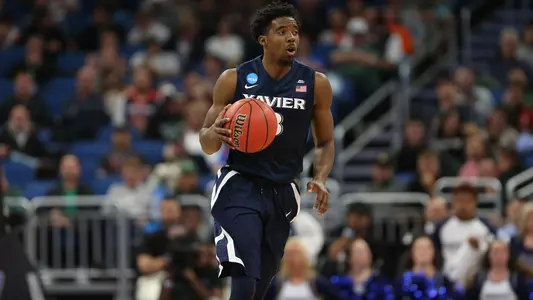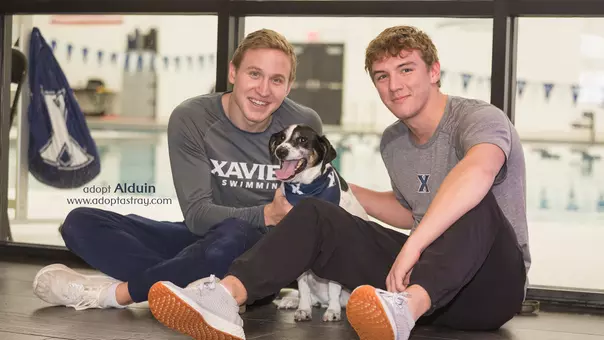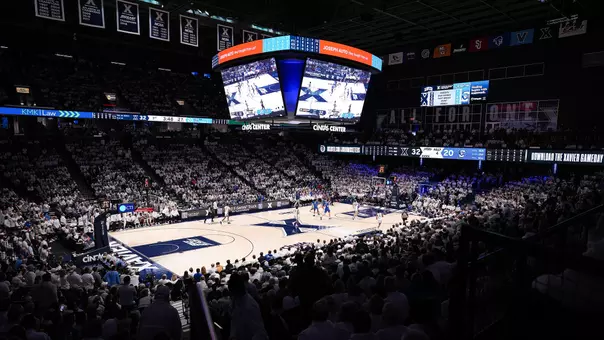Xavier University Athletics

Xavier Nation Magazine Feature: Stepping Up Their Game
09.11.17 | Athletic Department, Featured
A Freshman point guard and savvy veterans lead a surprising run to the Elite Eight
Perhaps one of the significant plays along Xavier's unexpected road to the Elite Eight didn't take place in any of the three NCAA Tournament victories over better-seeded teams. It didn't take place in the BIG EAST Championship, or the victory over DePaul that snapped a six-game losing streak, or even anytime in the regular season.
Maybe this impactful play took place in the first practice of the season, when standout point guard Edmond Sumner's step-back jumper left callow newcomer Quentin Goodin sprawled on the floor.
Goodin explains: "I was playing like a freshman, trying to make a big-time play for my team, and I gambled on defense. Ed got the ball and took it into the lane, and when he stepped back, I fell. And that's when I realized, Ed's good."
Says Travis Steele, XU's associate head coach: "It was, Welcome to Division I basketball."
But it was also then that Goodin realized how much he needed to do to develop into a player who could be counted on at both ends of the floor. He would soak up everything coaches had to say and teammates could show him. He'd watch film with Steele. And he'd emulate Sumner.
So by the time Sumner was lost for the season to a knee injury in January, Goodin, the 6-foot-4 freshman from tiny Campbellsville, Kentucky, had laid the groundwork for a bigger role. He learned on the fly, took his lumps and became a big reason why the Musketeers could weather a midseason swoon to mount their first Elite Eight run in head coach Chris Mack's tenure.
Maybe Xavier was able to get back up in part because Goodin did.
"There were some early practices where Edmond went at Quentin pretty good and crushed him a little bit," Steele recalls. "But I think that opened his eyes.
"Quentin went to a small school. He played against guys who just played basketball for fun. I told him this is a completely different level, and if he's not ready, mentally, every single day, then he's got no chance."
As the season unfolded, Goodin played mostly when Sumner didn't. He had some nice moments—11 points and four assists vs. Buffalo, six assists vs. Eastern Washington—but was inconsistent, like many freshmen. The Crosstown Shootout was a big step forward. XU lost, but Goodin finished with seven points and six assists in 15 minutes in a performance less about the numbers than about not shrinking from the moment.
"In the Crosstown, you never know what you're getting with a freshman; you can have a great freshman and they can be awful in that setting," Steele says. "But Q was incredible. He was getting into the teeth of the defense and making great decisions. We were like, 'Holy cow, this kid is really getting better.' I remember us thinking we might play those two [Sumner and Goodin] a little more together."
Three days later, in a victory at St. John's, that idea was quashed. Sumner blew out his knee. Suddenly, Goodin wasn't just running the offense; he was more or less a one-man show.
"He had to know from us that it was OK to miss a shot or make a mistake," Mack says. "But what wasn't going to be acceptable was to put your head down or feel sorry for yourself after those mistakes. Because we didn't have that luxury anymore."
Says Goodin: "After Ed got hurt, RaShid [Gaston] and Malcolm [Bernard]were like, 'It's time to take over. We're all looking at you when something goes wrong.' I had no other option but to become that player."
• Goodin had to develop the stamina to multiply his minutes while maintaining his effectiveness. "He went from playing 14 minutes a game to 35," Mack says. Adds Steele: "It's hard to play hard for that many minutes against the level of competition in the BIG EAST." Starting XU's final 17 games, Goodin averaged 35.5 minutes, including 39 four times and 40 once. Steele says the XU staff got in the habit of giving Goodin a rest at around the 14-minute mark of both halves, to give him two minutes of game time and the 12-minute TV timeout as a break. XU also used more zone (see sidebar) to give Goodin rest and protect him from difficult man-to-man matchups, and ran some offense through leading scorer Trevon Bluiett.
• He had to have complete mastery of what XU ran—not only his functions, but everyone else's—and find the voice that would enable him to become the kind of leader a point guard needs to be. "It's the hardest position to learn for a freshman," Steele says. "I always wondered if the older guys would listen to me, respect what I had to say," Goodin sayd. "And they did. If I saw something and I was trying to help, they would listen." One example: After Gaston didn't like a foul call, it was Goodin who got in his ear and calmed him down and told him he'd find him on Xavier's next possession. It resulted in a dunk for Gaston.
• And, he needed to learn to still run the team effectively even when he wasn't playing his best. "He can be really hard on himself. That's one thing if you're playing 12 minutes; the coach can pull you and you can be hard on yourself on the bench," Mack says. "But it's another thing if you turn the ball over against the press, and you know you're getting the ball right back the next time. You've got to break it. You can't run and hide. It was good to see him be able to do that."
Turnover-prone early in the season, Goodin ranked second in the BIG EAST in assist/turnover ratio (2.2 to 1) and fourth in assists (3.8) in conference games. Though not the scorer Sumner was, he trailed only Bluiett and J.P. Macura in scoring over three games at the BIG EAST Tournament. And in the NCAA Tournament, where No. 11 seed XU beat teams seeded sixth (Maryland), third (Florida State) and second (Arizona), Goodin matched a program record with nine assists vs. FSU.
During the West Regional, Sumner said of Goodin, "I just try to keep him up, keep his spirits up, keep his confidence high and let him know there's going to be ups and downs … if he's calm and collected, everybody else follows."
Goodin roomed with Sumner during the tournament. They would watch other games on off days, and Sumner would offer commentary on anything he saw that he thought might help.
"Ed's big time," Goodin says. "Ed made me the player that I am. He texted me all the time during the BIG EAST tournament. When he was healthy, if he'd do something and score in practice, he'd teach me how he did it. Me and him are similar type players, except he's 6-6 and crazy athletic. We both want to shoot the ball better."
That's on Goodin's to-do list for the summer: developing a more consistent jump shot. He hit .350 from the field, .255 from 3-point range, as a freshman, and admitted to tinkering frequently. "Every time I miss a shot, I change my shot," Goodin says. "I feel like when I change it, something good's going to happen."
Steele says the staff wants to work with Goodin on a consistent, repeatable release and then call an end to the tinkering.
"We did that with Trevon as well after his freshman year," Steele says. "We moved it over to the right side of his body. That's what Quentin needs to do, so it's the same shot every time. We want to raise it as well, because he's 6-4; he shoots like a 5-10 kid. He should have a high release point. I think he's going to be very good shooter in time."
Goodin has already proven that he can improve in time.
"We feel great about his future," Steele says. "He should feel great about it as well."
Maybe this impactful play took place in the first practice of the season, when standout point guard Edmond Sumner's step-back jumper left callow newcomer Quentin Goodin sprawled on the floor.
Goodin explains: "I was playing like a freshman, trying to make a big-time play for my team, and I gambled on defense. Ed got the ball and took it into the lane, and when he stepped back, I fell. And that's when I realized, Ed's good."
Says Travis Steele, XU's associate head coach: "It was, Welcome to Division I basketball."
But it was also then that Goodin realized how much he needed to do to develop into a player who could be counted on at both ends of the floor. He would soak up everything coaches had to say and teammates could show him. He'd watch film with Steele. And he'd emulate Sumner.
So by the time Sumner was lost for the season to a knee injury in January, Goodin, the 6-foot-4 freshman from tiny Campbellsville, Kentucky, had laid the groundwork for a bigger role. He learned on the fly, took his lumps and became a big reason why the Musketeers could weather a midseason swoon to mount their first Elite Eight run in head coach Chris Mack's tenure.
Maybe Xavier was able to get back up in part because Goodin did.
"There were some early practices where Edmond went at Quentin pretty good and crushed him a little bit," Steele recalls. "But I think that opened his eyes.
"Quentin went to a small school. He played against guys who just played basketball for fun. I told him this is a completely different level, and if he's not ready, mentally, every single day, then he's got no chance."
|
|
"HOLY COW, THIS KID IS REALLY GETTING BETTER" |
As the season unfolded, Goodin played mostly when Sumner didn't. He had some nice moments—11 points and four assists vs. Buffalo, six assists vs. Eastern Washington—but was inconsistent, like many freshmen. The Crosstown Shootout was a big step forward. XU lost, but Goodin finished with seven points and six assists in 15 minutes in a performance less about the numbers than about not shrinking from the moment.
"In the Crosstown, you never know what you're getting with a freshman; you can have a great freshman and they can be awful in that setting," Steele says. "But Q was incredible. He was getting into the teeth of the defense and making great decisions. We were like, 'Holy cow, this kid is really getting better.' I remember us thinking we might play those two [Sumner and Goodin] a little more together."
Three days later, in a victory at St. John's, that idea was quashed. Sumner blew out his knee. Suddenly, Goodin wasn't just running the offense; he was more or less a one-man show.
"He had to know from us that it was OK to miss a shot or make a mistake," Mack says. "But what wasn't going to be acceptable was to put your head down or feel sorry for yourself after those mistakes. Because we didn't have that luxury anymore."
Says Goodin: "After Ed got hurt, RaShid [Gaston] and Malcolm [Bernard]were like, 'It's time to take over. We're all looking at you when something goes wrong.' I had no other option but to become that player."
|
|
AMONG THE CHALLENGES |
• Goodin had to develop the stamina to multiply his minutes while maintaining his effectiveness. "He went from playing 14 minutes a game to 35," Mack says. Adds Steele: "It's hard to play hard for that many minutes against the level of competition in the BIG EAST." Starting XU's final 17 games, Goodin averaged 35.5 minutes, including 39 four times and 40 once. Steele says the XU staff got in the habit of giving Goodin a rest at around the 14-minute mark of both halves, to give him two minutes of game time and the 12-minute TV timeout as a break. XU also used more zone (see sidebar) to give Goodin rest and protect him from difficult man-to-man matchups, and ran some offense through leading scorer Trevon Bluiett.
• He had to have complete mastery of what XU ran—not only his functions, but everyone else's—and find the voice that would enable him to become the kind of leader a point guard needs to be. "It's the hardest position to learn for a freshman," Steele says. "I always wondered if the older guys would listen to me, respect what I had to say," Goodin sayd. "And they did. If I saw something and I was trying to help, they would listen." One example: After Gaston didn't like a foul call, it was Goodin who got in his ear and calmed him down and told him he'd find him on Xavier's next possession. It resulted in a dunk for Gaston.
• And, he needed to learn to still run the team effectively even when he wasn't playing his best. "He can be really hard on himself. That's one thing if you're playing 12 minutes; the coach can pull you and you can be hard on yourself on the bench," Mack says. "But it's another thing if you turn the ball over against the press, and you know you're getting the ball right back the next time. You've got to break it. You can't run and hide. It was good to see him be able to do that."
Turnover-prone early in the season, Goodin ranked second in the BIG EAST in assist/turnover ratio (2.2 to 1) and fourth in assists (3.8) in conference games. Though not the scorer Sumner was, he trailed only Bluiett and J.P. Macura in scoring over three games at the BIG EAST Tournament. And in the NCAA Tournament, where No. 11 seed XU beat teams seeded sixth (Maryland), third (Florida State) and second (Arizona), Goodin matched a program record with nine assists vs. FSU.
During the West Regional, Sumner said of Goodin, "I just try to keep him up, keep his spirits up, keep his confidence high and let him know there's going to be ups and downs … if he's calm and collected, everybody else follows."
Goodin roomed with Sumner during the tournament. They would watch other games on off days, and Sumner would offer commentary on anything he saw that he thought might help.
"Ed's big time," Goodin says. "Ed made me the player that I am. He texted me all the time during the BIG EAST tournament. When he was healthy, if he'd do something and score in practice, he'd teach me how he did it. Me and him are similar type players, except he's 6-6 and crazy athletic. We both want to shoot the ball better."
That's on Goodin's to-do list for the summer: developing a more consistent jump shot. He hit .350 from the field, .255 from 3-point range, as a freshman, and admitted to tinkering frequently. "Every time I miss a shot, I change my shot," Goodin says. "I feel like when I change it, something good's going to happen."
Steele says the staff wants to work with Goodin on a consistent, repeatable release and then call an end to the tinkering.
"We did that with Trevon as well after his freshman year," Steele says. "We moved it over to the right side of his body. That's what Quentin needs to do, so it's the same shot every time. We want to raise it as well, because he's 6-4; he shoots like a 5-10 kid. He should have a high release point. I think he's going to be very good shooter in time."
Goodin has already proven that he can improve in time.
"We feel great about his future," Steele says. "He should feel great about it as well."
PRESS CONFERENCE | Richard Pitino (12-15-2025)
Monday, December 15
INTERVIEW | Coach Chambers vs. Saint Francis
Sunday, December 14
HIGHLIGHTS | Women's Basketball vs. Saint Francis
Sunday, December 14
HIGHLIGHTS | Men's Basketball vs. Missouri State
Saturday, December 13




